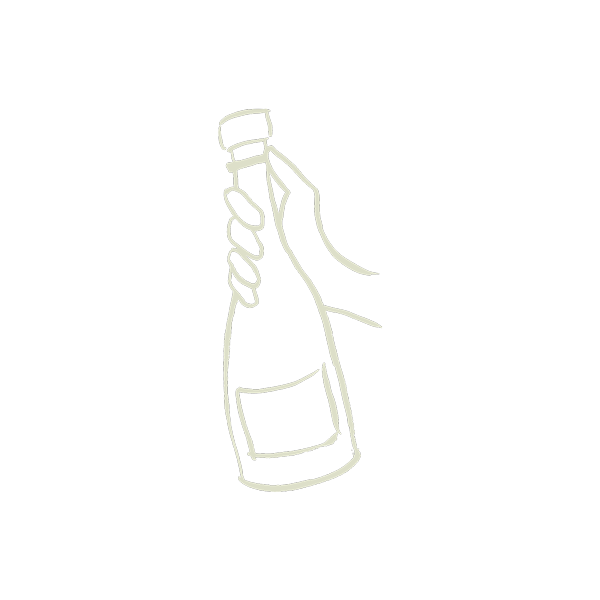Biodiversity at Hervieux-Dumez

Hervieux-Dumez keeps bees in the forested areas adjacent to their vineyards. The pollinators fertilize ground cover between the vines and help with pest control.
Prized for their ability to make honey, support the hive and pollinate 80 percent of the world’s flowering plants, bees have long been used by humans to symbolize productivity, community and rebirth. For winemaker Clément Hervieux of Hervieux-Dumez, the bee has also come to represent a fresh, new chapter of the family's robust legacy. Before Clément stepped into his role as a fourthgeneration vigneron at Hervieux-Dumez, bees only casually buzzed their way among the vineyards of pinot noir, pinot meunier and chardonnay. Since Champagne grapes self-pollinate, the bees had no defined purpose among the vines. And for generations bees would simply come and go while growers went about their work employing the methods and wisdom passed down through the family for more than 100 years.

Hervieux-Dumez Through the Generations
The Hervieux-Dumez story began in 1920 when Henri Hervieux, a World War I veteran stationed in Sacy, a small Premier Cru village in Montagne de Reims, met and fell in love with Juliette Dumez. The newlyweds settled in Sacy and began making Champagne under the name Hervieux-Dumez. In the 1950s, the couple’s son André and his wife, Simone, took over the family business. Recognizing the importance and significance of his Champagne legacy, during his tenure, André worked tirelessly to care for the estate and nurture the unique terroir of his vineyards.
Under André’s direction, Hervieux-Dumez continued to earn accolades and with it a reputation for excellence. He expanded the domaine, purchasing vineyards in the neighboring Premier Cru villages of Ecueil and Chamery. In 1971, he secured a place for Hervieux-Dumez in the Club de Viticulteurs Champenois, which later became Club Trésors de Champagne and is still active to this day. This elite group of grower-producers is united around their dedication to making “Special Club” cuvées from the best vintages of grapes that are the most expressive of their subregion’s terroir as well as bringing awareness to their ability to produce the best Champagne in the world.
In the decades that followed, a third generation — André’s sons Bruno and Laurent — took the reins, continuing the family tradition and bringing experience and fresh perspective to the business of making beautifully balanced, albeit higher-dosage, Champagne.

Hervieux-Dumez and Fatcork
It is here, with the brothers at the helm, that fatcork founder Bryan Maletis first discovered HervieuxDumez in 2012. Tipped off by other fatcork growers, he was eager to meet the vignerons and taste the Champagnes he had heard so much about. Bryan was enamored with their Special Club vintage cuvées as well as with the base wines that he tasted straight from the barrel during his visit to the estate.
Over the years, Bryan got to know Bruno’s son Clément, who had been working at the domaine since 2011. As Clément and Bryan’s relationship grew, they shared many conversations about the direction of the domaine and bonded over their preference for very dry Champagne. When Bruno retired in 2017, Clément joined Laurent as vigneron of the estate. That same year, with the U.S. customer in mind, Clément asked fatcork for input on several new low-dosage and nature cuvées that eventually made their way into Fatcork’s portfolio.
Hervieux-Dumez Welcomes Biodiversity
As Clément became more involved at the estate, he and Laurent began implementing changes that would take Hervieux-Dumez into its new chapter. In 2020, they began the work of transitioning the domaine to organic and biodynamic. According to the rules of organic agriculture, growers must avoid the use of chemical pesticides, herbicides, fungicides and fertilizers. Biodynamic farming requires that vignerons also follow specific planting cycles, use natural fungicide made from herbs and other plants, and use livestock and animals to help fertilize the vineyards.
To that end, the vignerons planted native ground cover and colorful flowers between the vines. The plants introduce nitrogen into soil, which in turn creates the ideal conditions for earthworms that enrich and fertilize the land. An amateur beekeeper, Clément brought bee hives onto each of the family plots. The bees pollinate the plant cover, helping to conserve water and create a welcoming environment for insects that settle among the plants and protect the vines from unwanted pests. Chickens roam free among vines to help keep “budeating” caterpillars at bay without the use of harmful pesticides. Their presence also introduces more organic matter into the soil, and their characteristic scratching helps control weeds naturally.

Today, bees are a welcome and encouraged part of the landscape, and for Hervieux-Dumez, the buzzing insect has come to represent more than just the health of its vineyards. The symbol of the bee, proudly emblazoned on the producer’s logo since 2021, is a reflection of Hervieux-Dumez’s identity and its vignerons’ commitment to nurturing and caring for the land that has been passed down through the ages.
In this allocation, you’ll discover two of our favorite Champagnes from Hervieux-Dumez: Rosé Premier Cru Extra Brut and Extra Brut Réserve Premier Cru. (The producer made the latter with a custom 4 g/l dosage exclusively for fatcork!) Notice the bee on the labels of both bottles, and while you’re sipping the cuvées on a warm summer day, give a little nod to nature in balance from the vineyards to the bubbles in your glass.

Today, Hervieux-Dumez vignerons Laurent, Clément (pictured above in the production house) and Laurent’s son Timothée, oversee every step of the winemaking process from start to finish.

